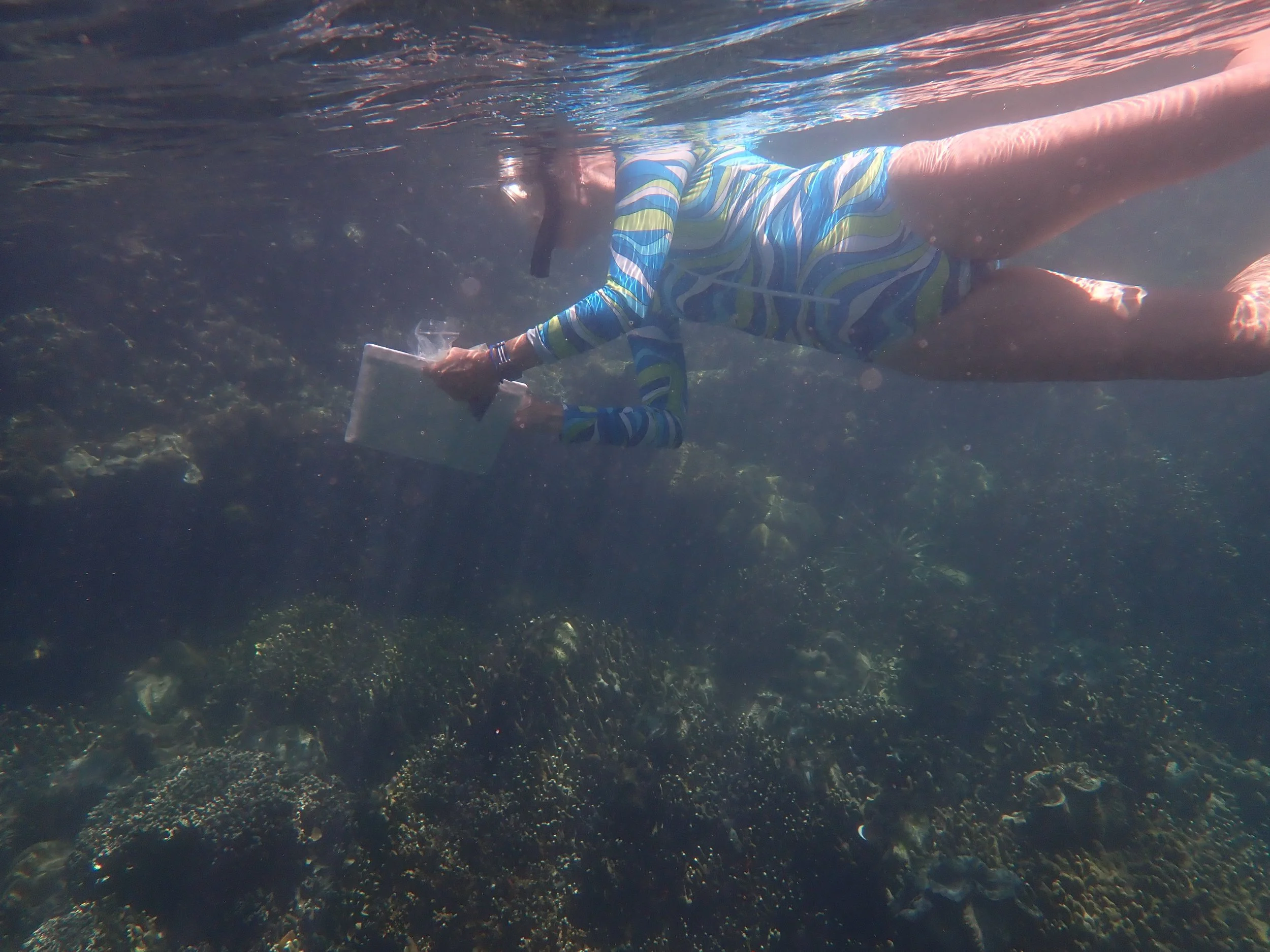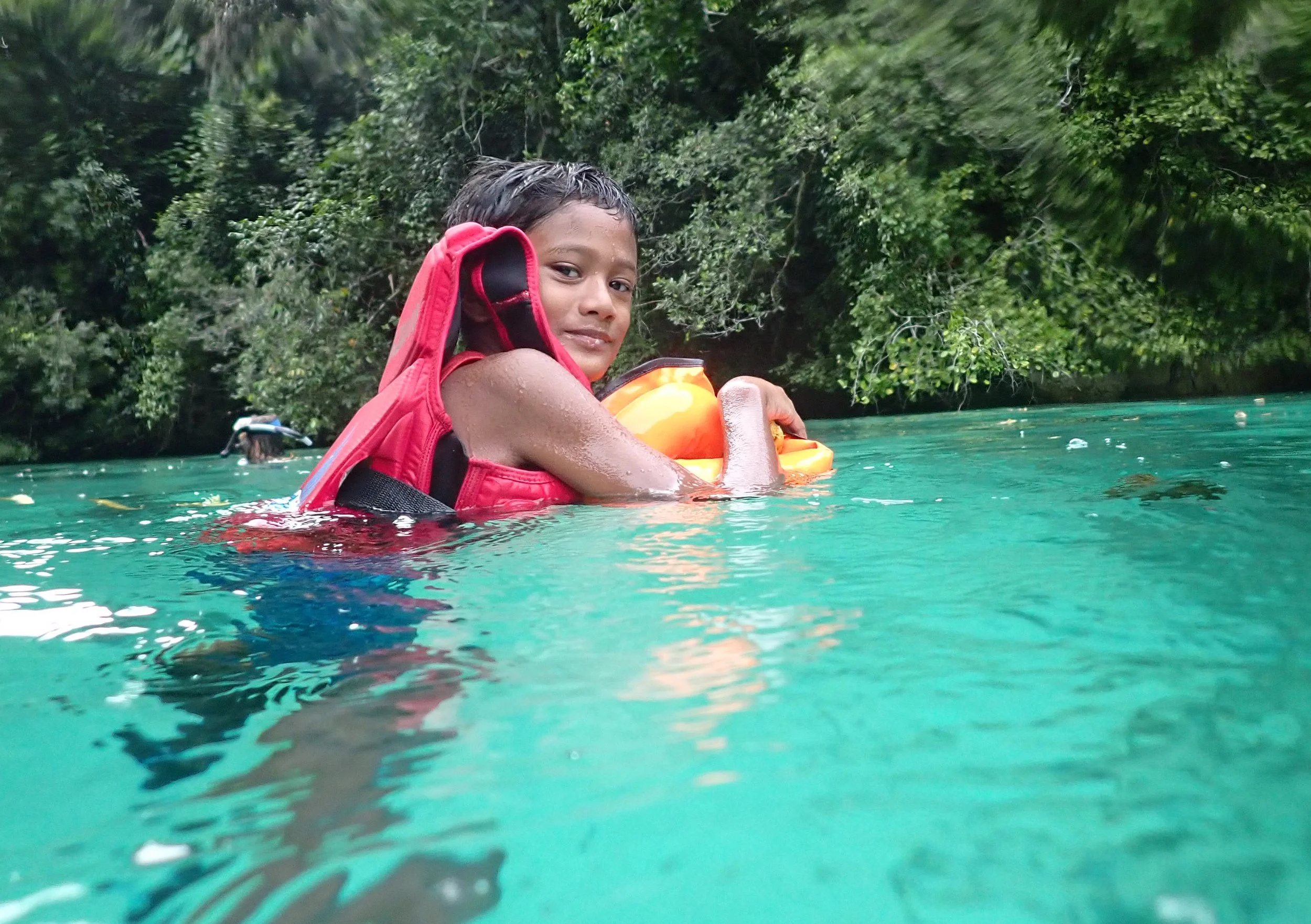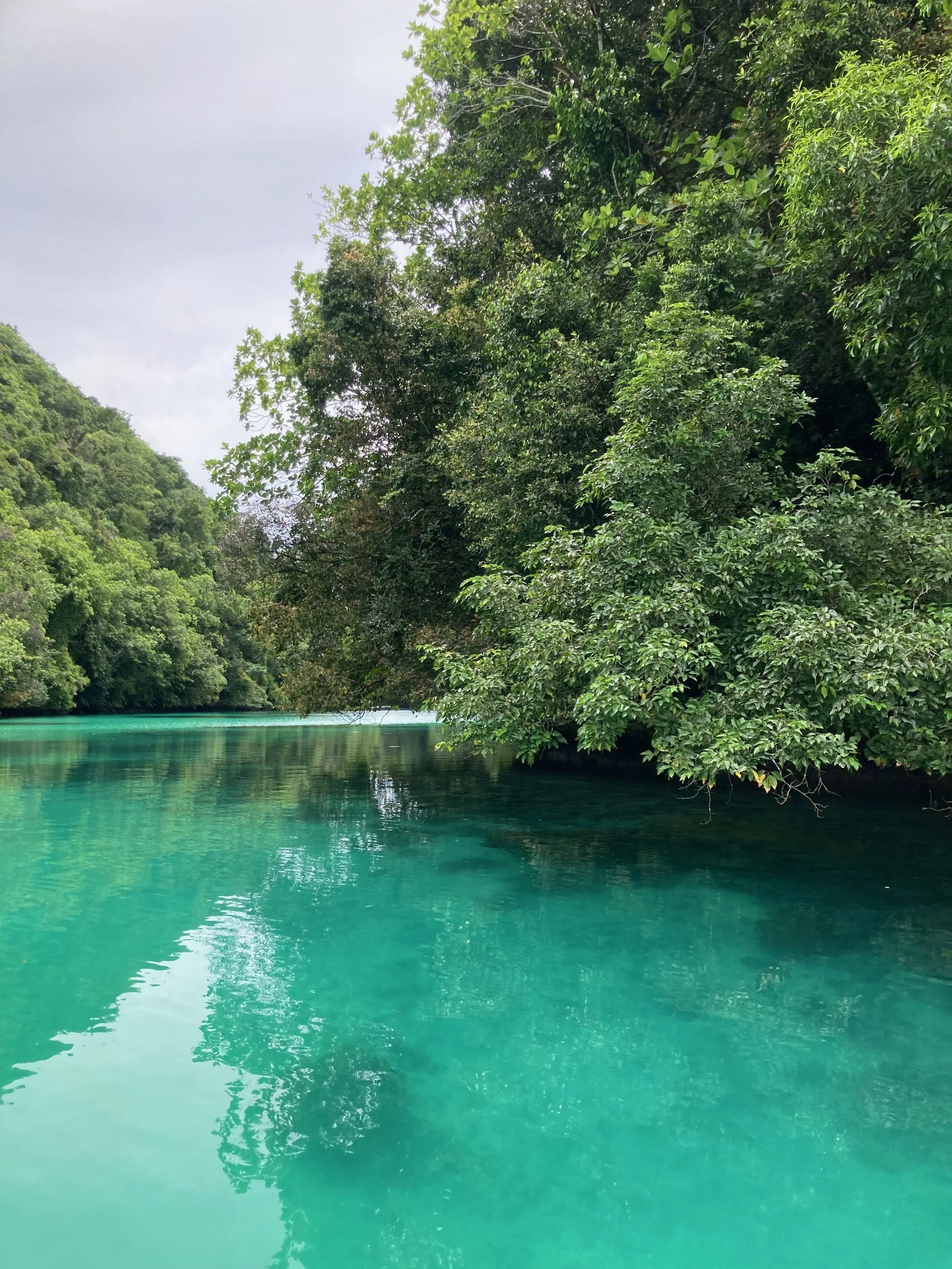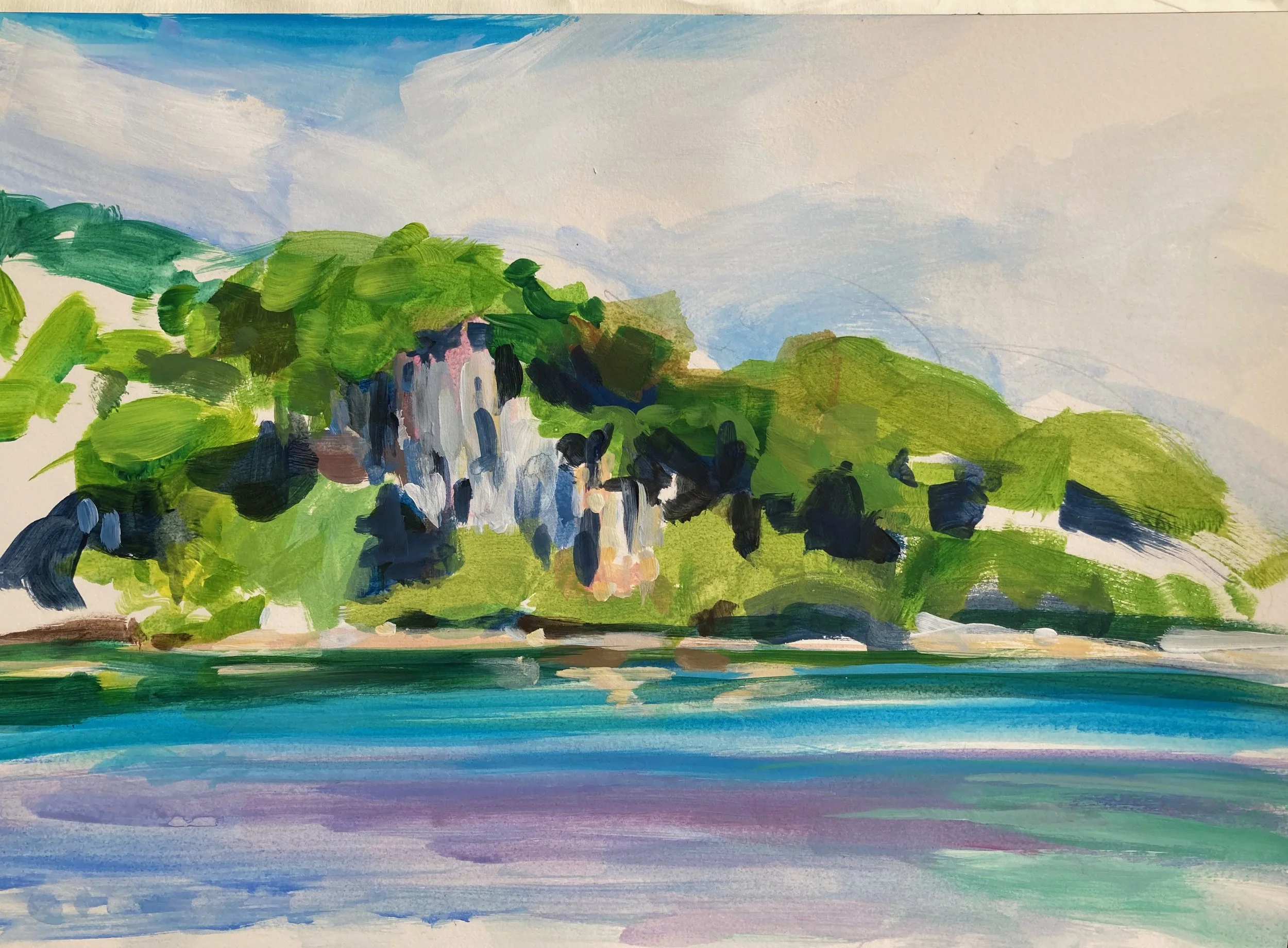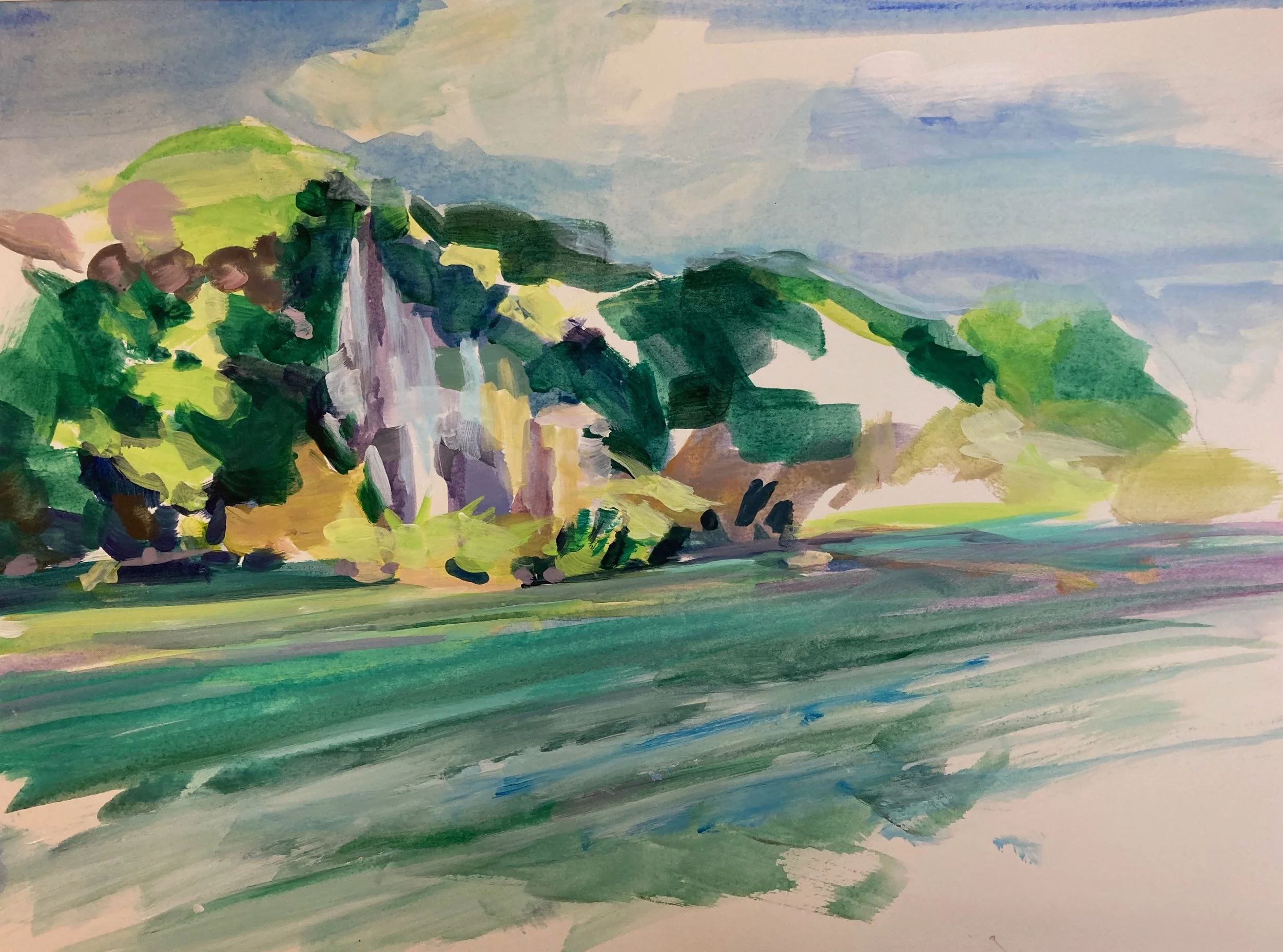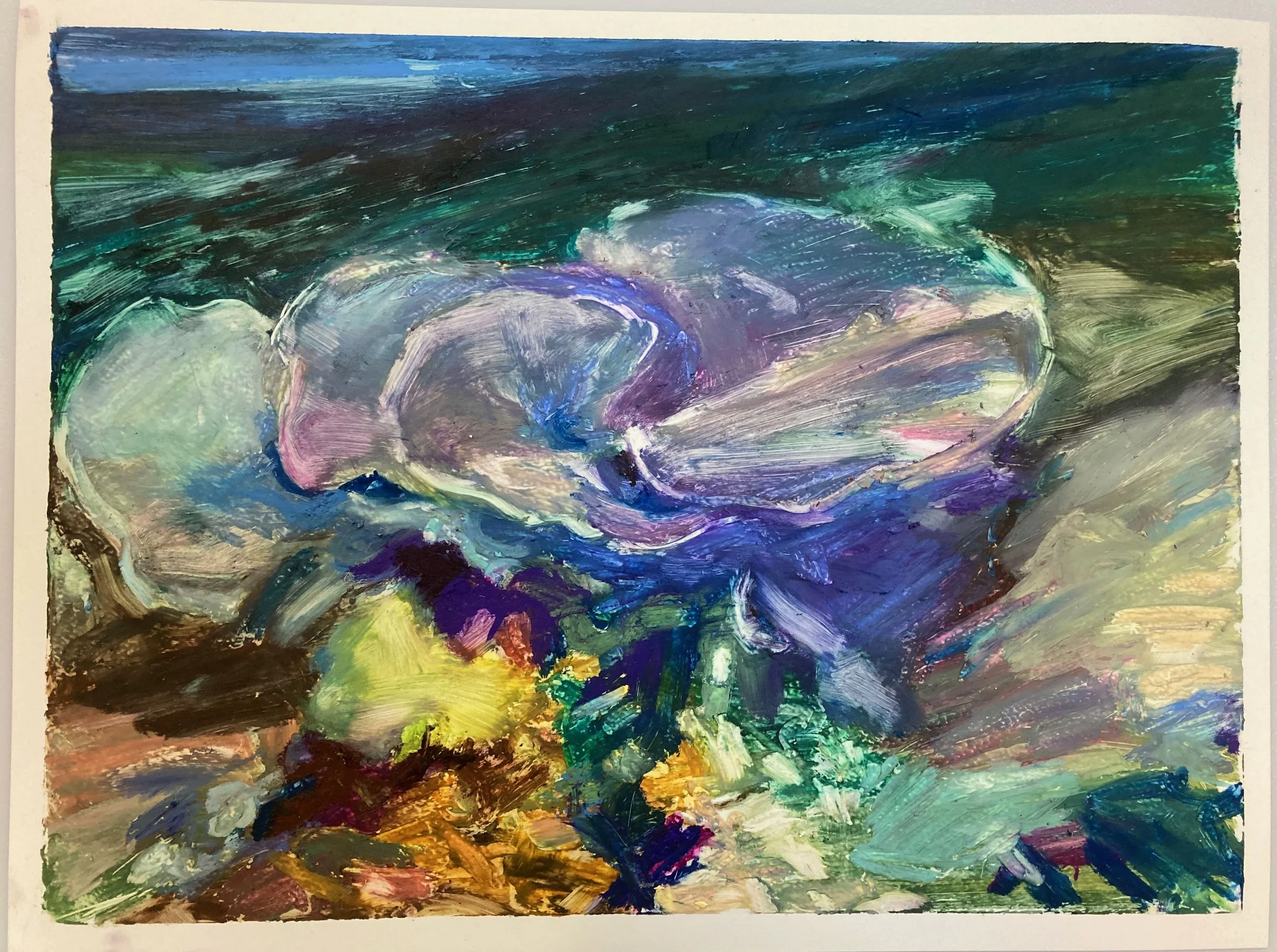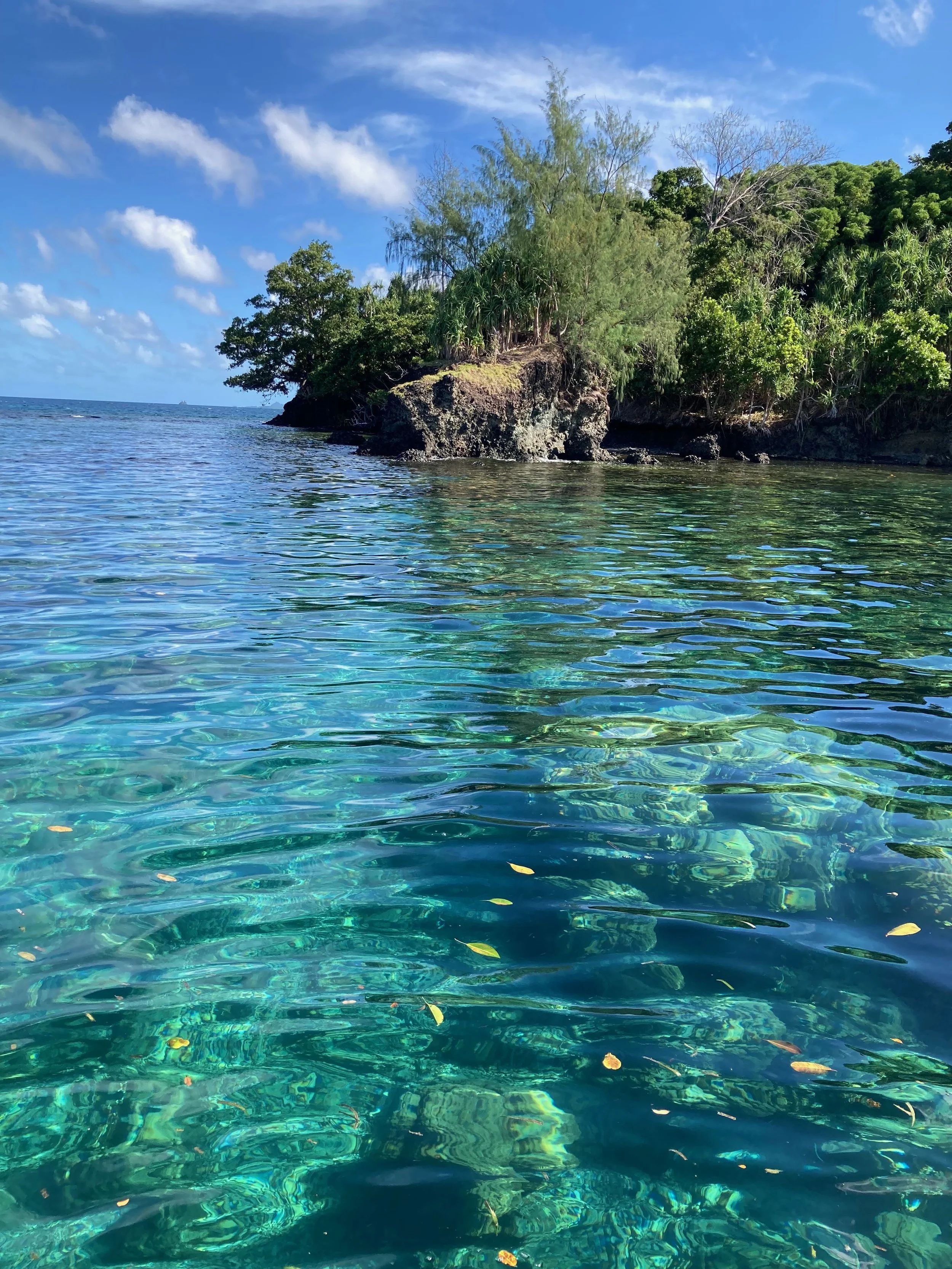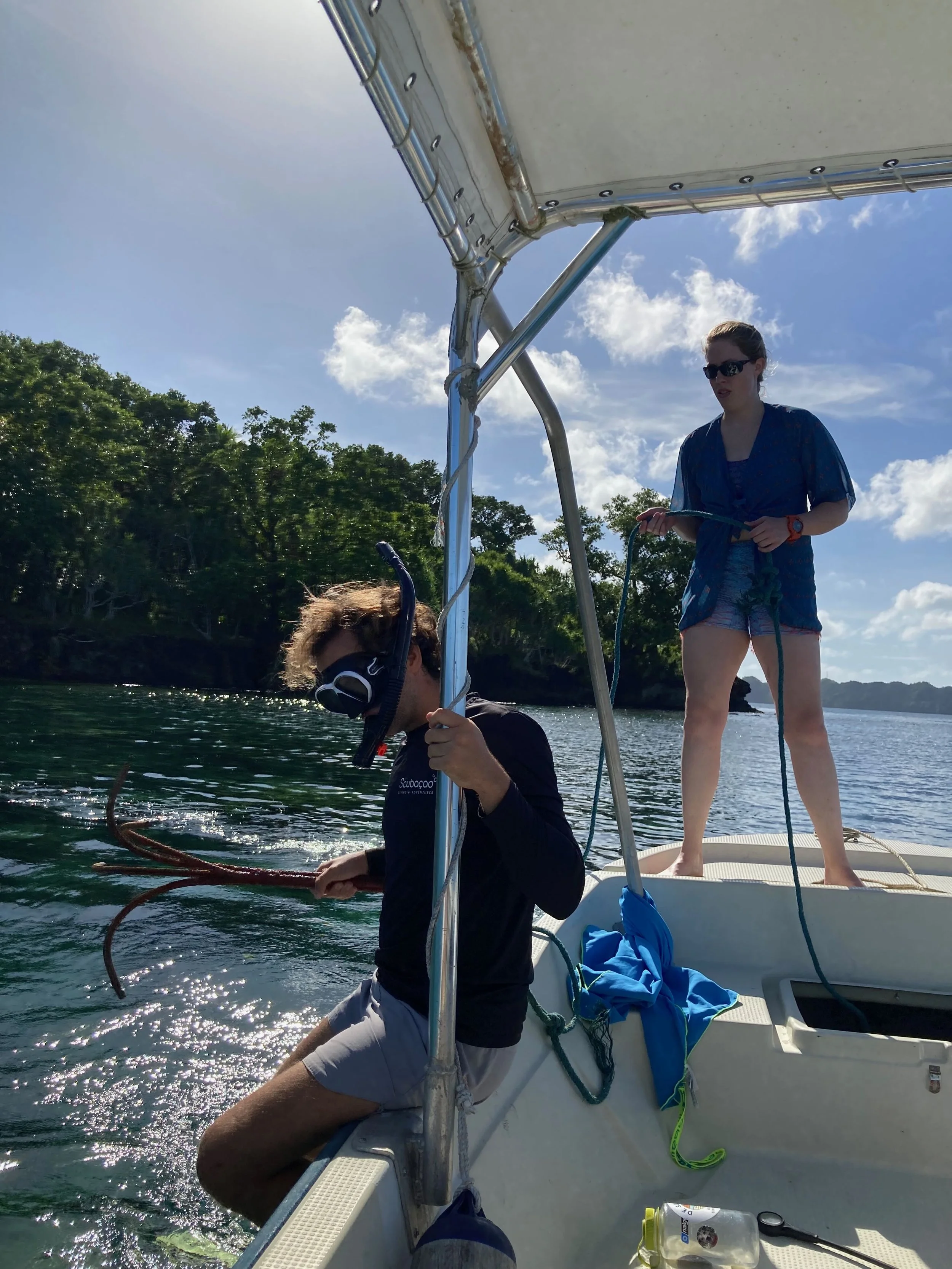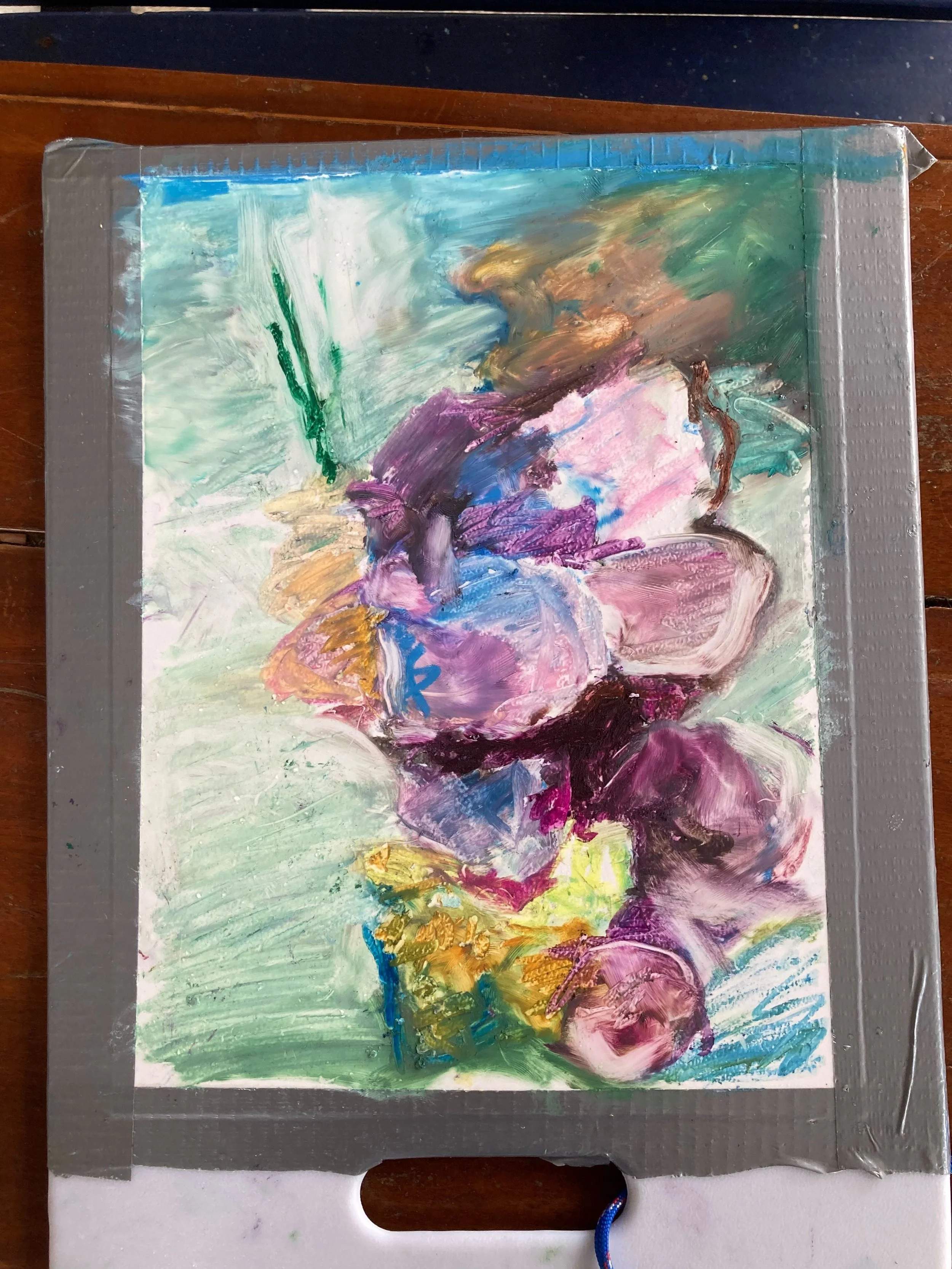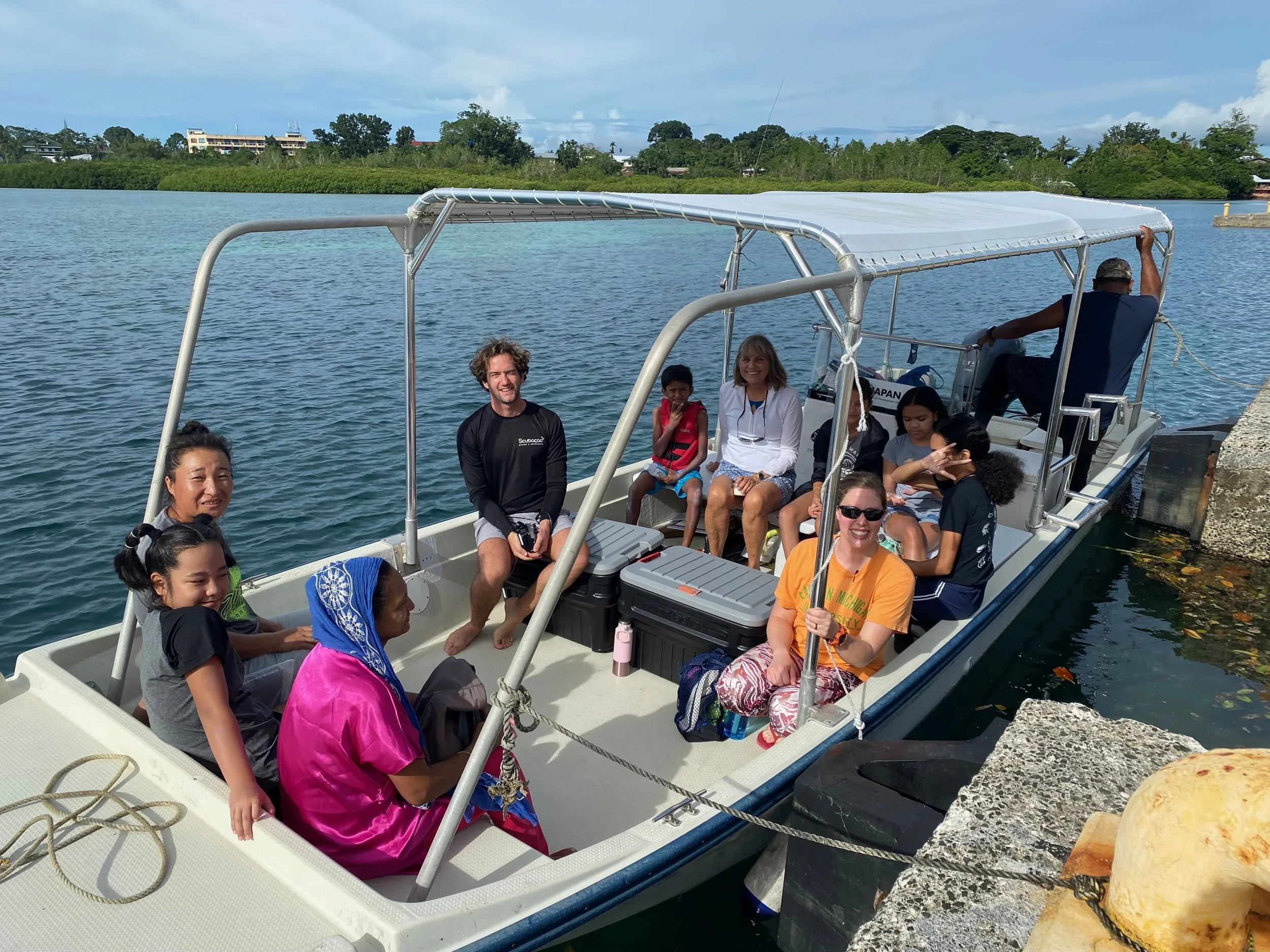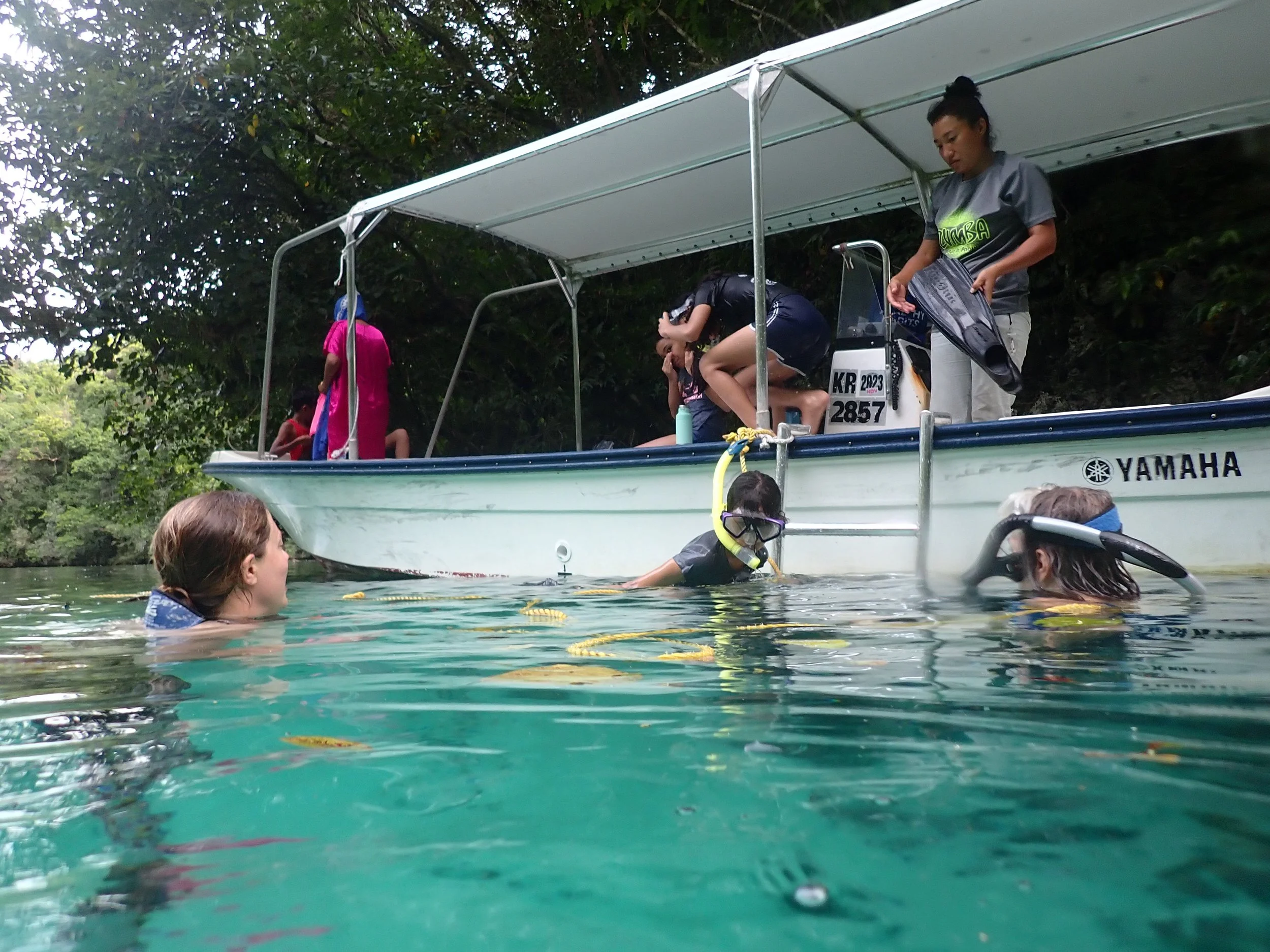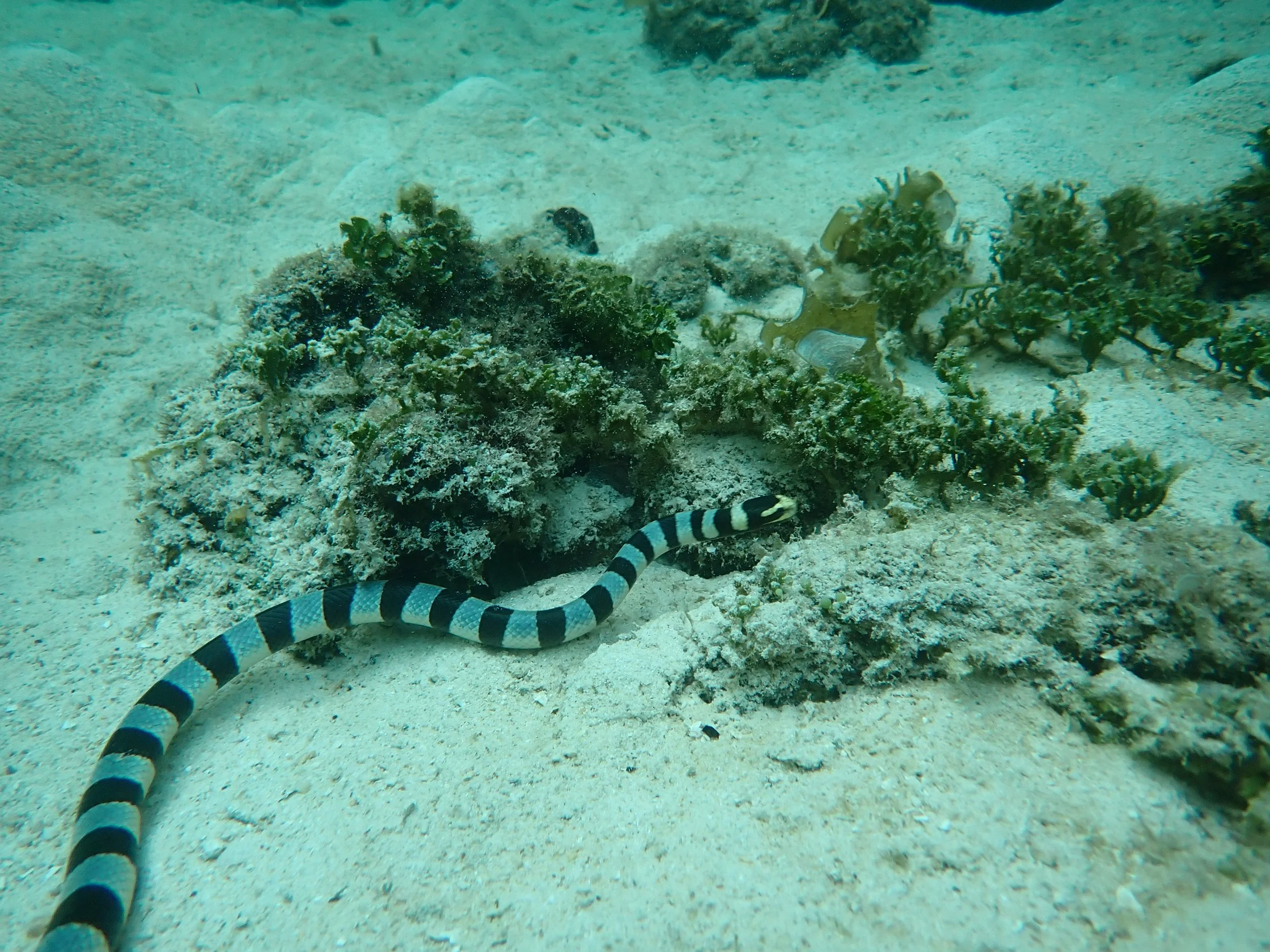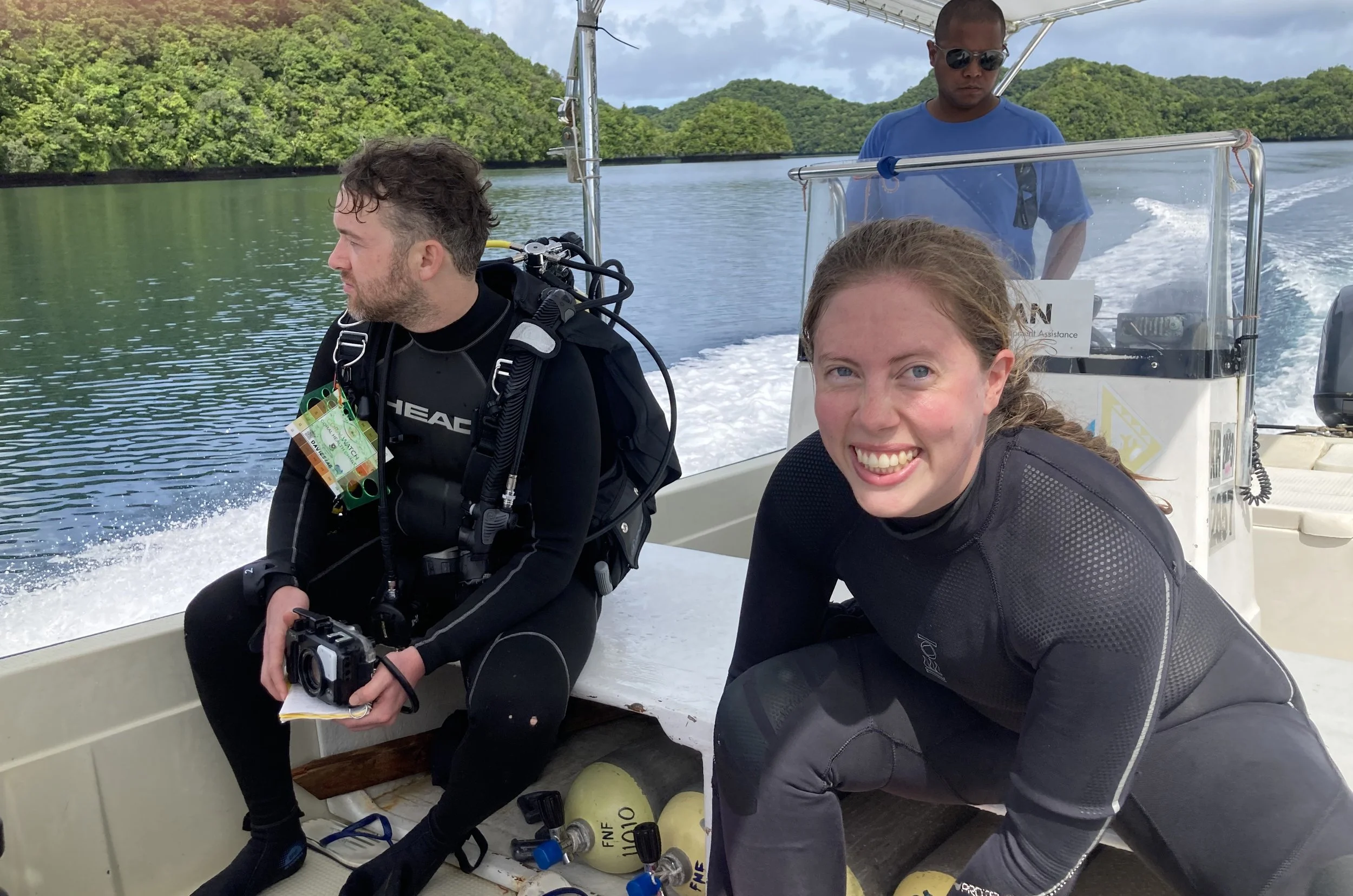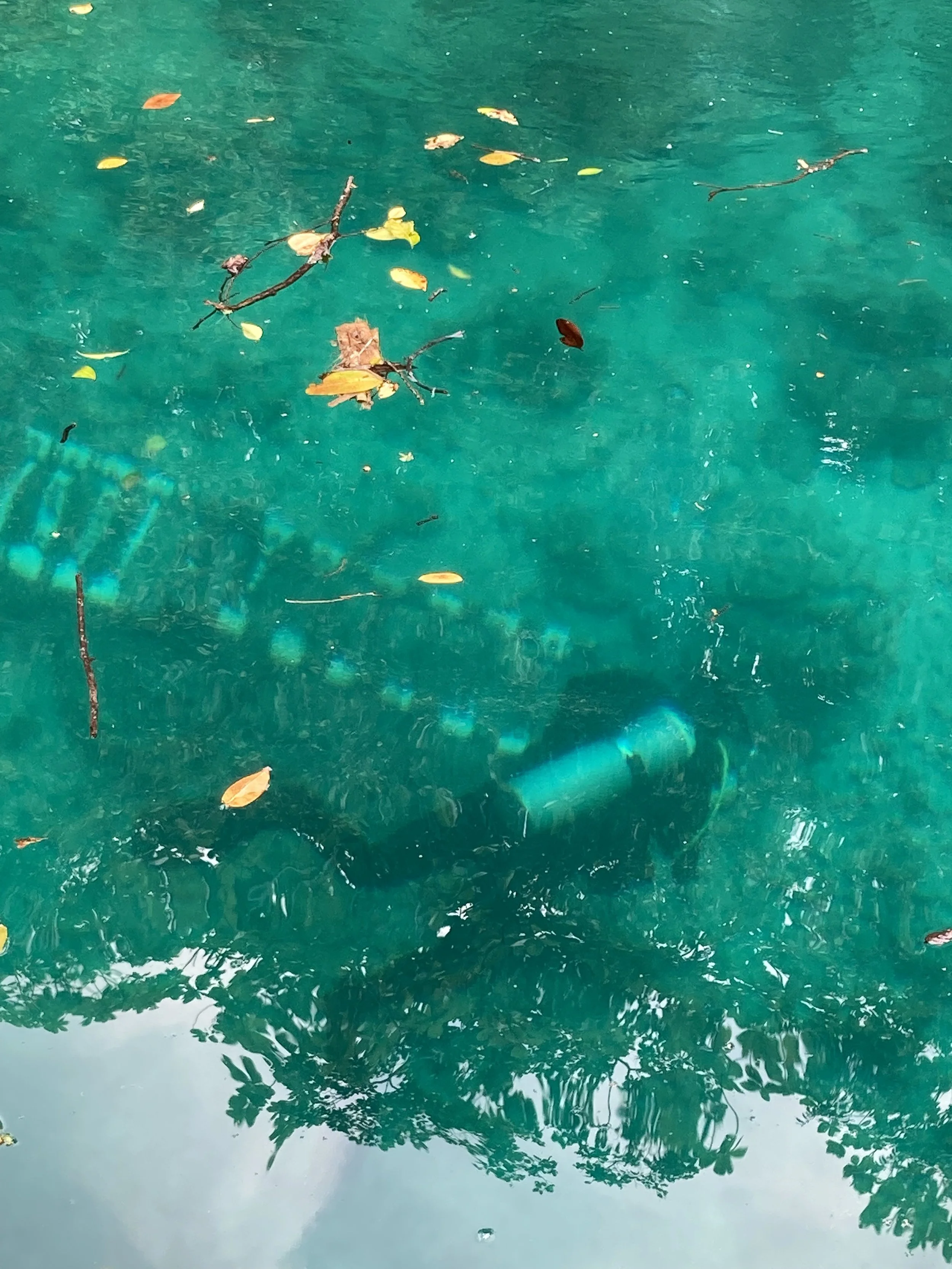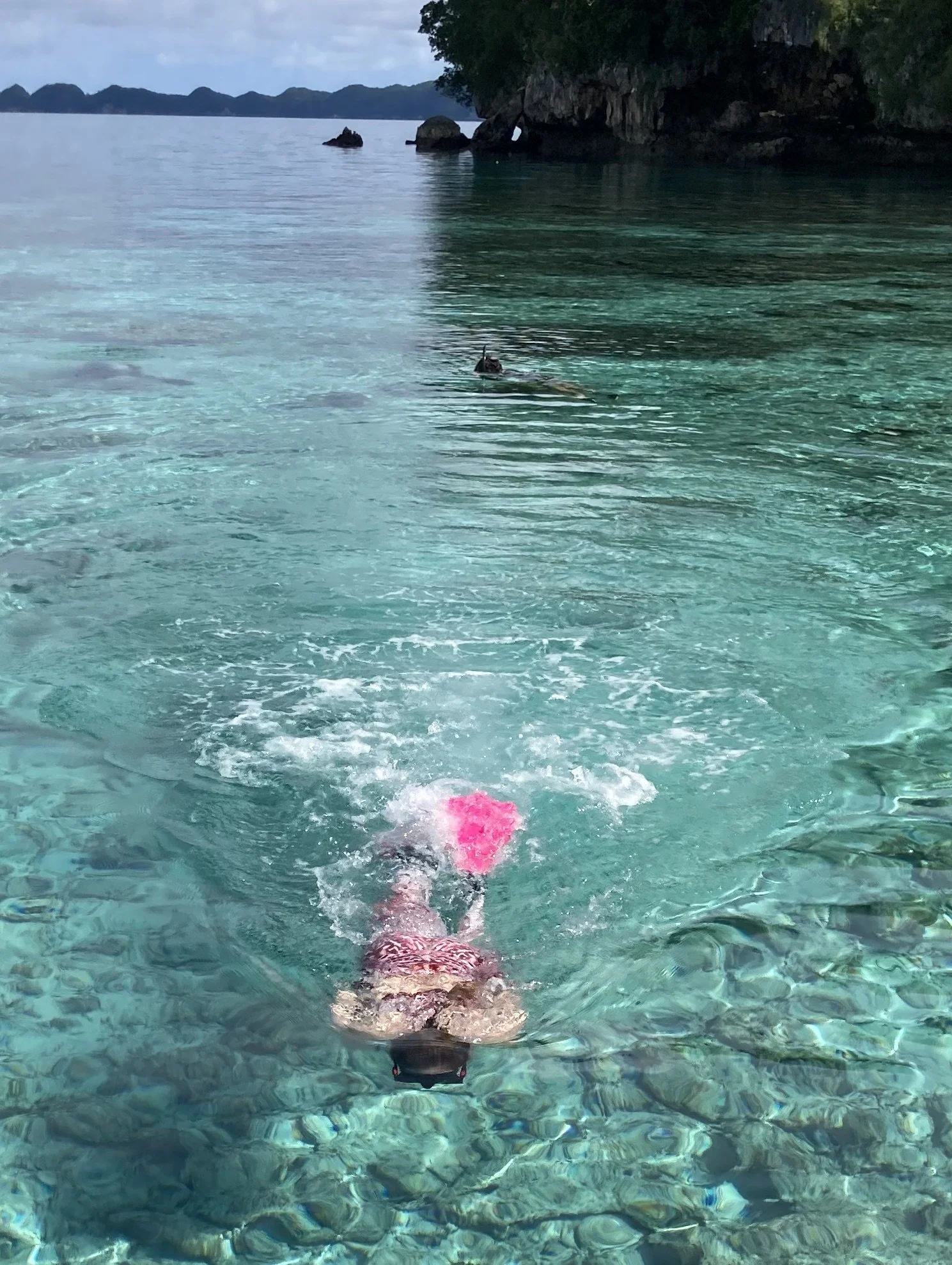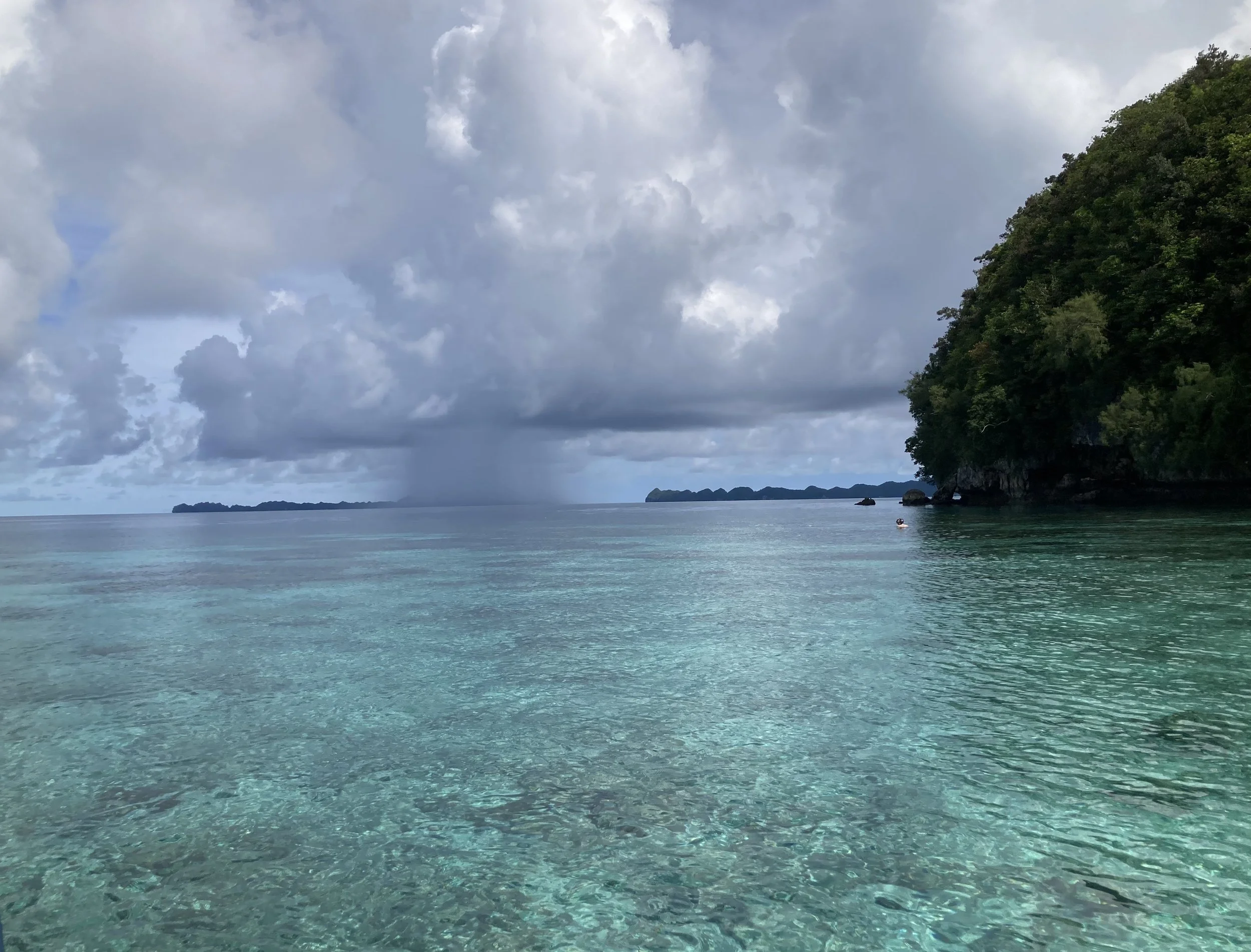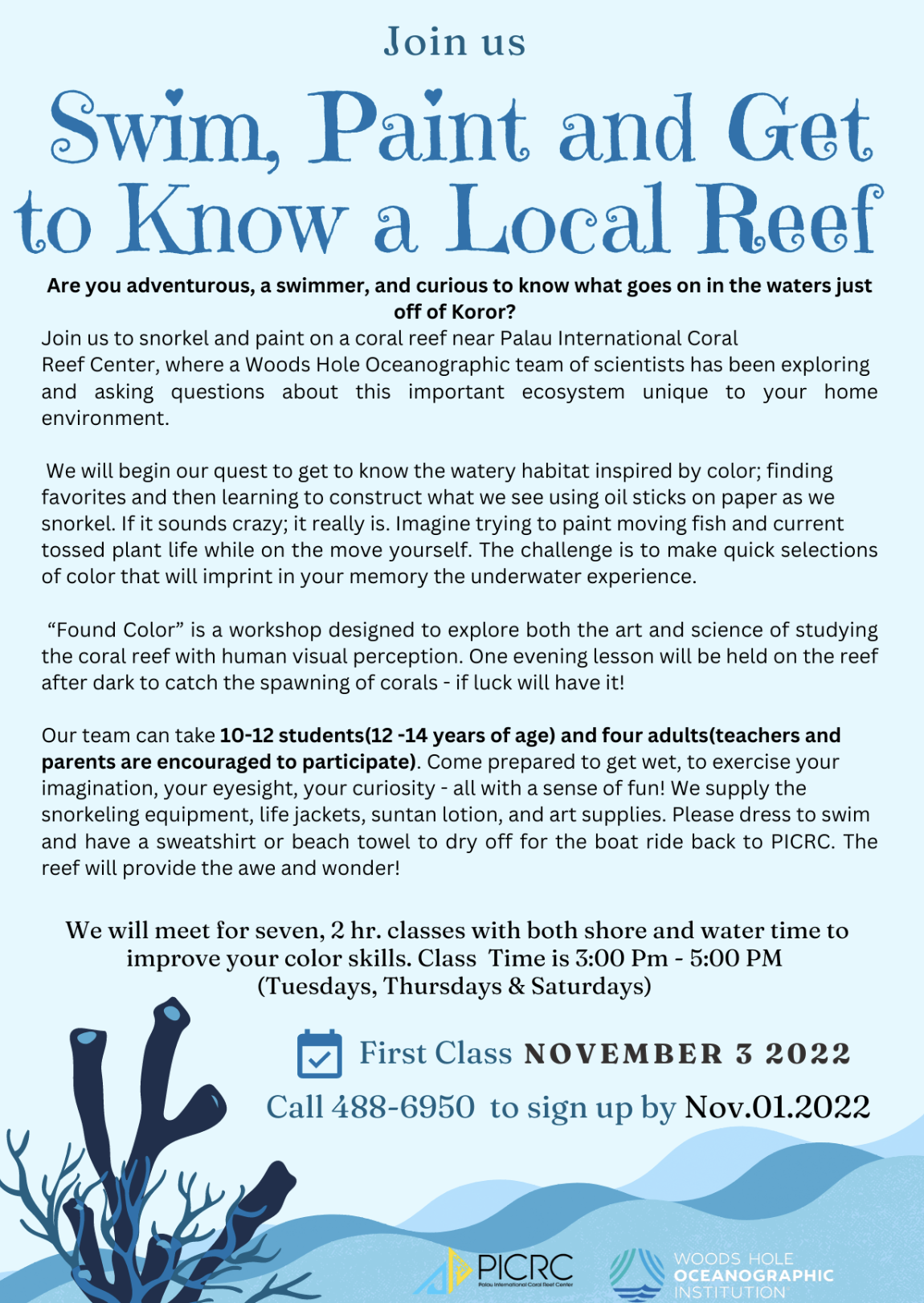Found Color
PICRC I Palau International Coral Reef Center, Republic of Palau
ARTIST RESIDENCY | November 2022
JOURNAL
During this artist residency I will be painting at a number of sites around Palau and leading a “Found Color” workshop for a small group of middle school students living on the island of Koror.
The science team from Woods Hole Oceanographic Institute that I am traveling with, led by Dr. Kirstin Meyer-Kaiser, will continue their research of corals in anticipation of one species spawning just after the full moon. Together we will share our methods of study on location guiding the students making their first underwater explorations of the reefs.
Edge of the Rock Islands, from below 2008
Workshop
November 2022
This program is designed for kids and adults — to explore their coral reefs - visiting sites in close proximity to the Palau International Coral Reef Center.
Among a number of science and art activities, we will snorkel off shore and experiment with underwater drawing and painting techniques I use in my landscape work, to experience the world of light and color below the surface of water.
Journal
Scroll down to begin reading, November 2 - 19, 2022
EPILOGUE
A long Look
Our last afternoon in the Rock Islands at “Clam City”. Photo - Carston Grupstra
Time to swim and observe the colorful marine life on the coral reefs of Palau is a luxury. Even more valuable - is to share the experience with young Palauans who will inherit the management of this precious habitat alongside the visiting scientists who look for ways to assist them. Nowhere does the adage, “We are all in the same boat” have more meaning; it illustrates our human connection to the condition of our planet’s environment and our personal responsibility to live in respect to Mother Earth each and every day.
The three week schedule of “Found Color” boat trips delivered our crew to dazzling sites in the Rock Islands of the Republic of Palau during November. We left our land-bound cares behind, gleefully free-falling into the warm waters of a Pacific playground. Our personal underwater observatory, a mask and snorkel, quickly empowered the swimmers to dive and seek the spectacular; find their favorite exotic creatures, while recording the hues that fascinated them - just as artists for millennia have gawked, exalted, and responded with amazement in the presence of nature.
To paint what was before us was taken in stride and embraced with courage by everyone! How crazy it seemed to kick and float, fumble with the oil sticks, try to make an image to capture what we were witnessing in the fluid dance, coming and going over the coral reef. But each new painting returning to the boat with a personal vision in full color on YUPO paper was a challenge accepted. The process of building color memory and curiosity was the real gift for making the effort.
I continue to struggle to paint underwater, as I did in 2008 on my first visit to Palau. Then, I was keen to show the relevance of working in situ. I wanted to correct the inaccuracies of underwater color photography for recording human perception of the pristine reefs Palau had spent 20 years protecting and patiently allowing then to return to health. I left after a month of diving, painting above and below the water, feeling like the task was too difficult to be accomplished. With the luxury of time I now can see that my first trip had been an important color data point recording the healthiest reefs in the world - Mother Nature’s very best color display! I had taken a small step, but one that prepared me to return with knowledge of the reefs at their best to witness their struggle today to exist.
The luxury of time is never guaranteed. Neither is the clarity of perception or a finished artwork in spite of our efforts. But we can gain knowledge in each attempt to paint and construct the wonder of what we see in the marine ecosystem. Our failures and the precious successes all contribute to the color log that we keep as humans navigating our world. Art, as with science, gains relevance if we keep showing up in earnest pursuit of what makes us curious and compels us to say, “Hey, look at this!”. We had a boat load of artist/scientists in the Found Color workshop this November doing just that!
In search of Giant Clams at the end of M-Dock, PICRC Photo - Matthew-James Bennett
November 19, 2022
Clam City Fun Day
Dr. Kirstin Meyer-Kaiser(Woods Hole Oceanographic Institute) and her team are frenetic in their research habits - fueled by their passion for finding answers to questions about coral survival in the Pacific. They are perfect examples of what “Found Color” has been designed to inspire. Not only are they knowledgeable, diligent, and exacting researchers intent on making a difference on behalf of nature; all three are curious, creative, courageous, and fun! They had no trouble turning each “Found Color” activity into a joyful event suited to the children that signed up with various levels of ability and interest. The range of ages of the children made for a family affair - each of us looking out for someone who might need encouragement or a hand getting their bearings. Matthew-James gave just enough support to move MD(Mohamed) from, ”I will die in the water” to propelling himself across the surface with snorkel and mask to meet the clams of Clam City face to face on our final outing.
MD taking his first double-lifejacket cruise around the surface of Risong. Photo - Carston Grupstra
Found Color’s boat trip “finally” was planned for a visit to “Clam City” - well known for it’s large population of the majestic Giant Clam. Some specimens there in April 2008 were over 4 feet in length, weighing an impressive 500 lbs. - so large that they could no longer close as my shadow blocked their light - even to protect their syphons from debris or their colorful mantle from poachers. I was excited to share the fireworks of color of this natural wonder with our newly experienced underwater painters.
Our Boat Captain, Nelson, took us out to the Rock Islands and slowed down to pick up the buoy line marking the famous reef. Nothing about this location looked right to me as we arrived. The water was murky, not the highly reflective tropical shallows that I remembered. I had been to Clam City three times before and painted there with the help of the PICRC dive team - who ate their lunch while I worked below. I questioned Nelson, “Is there more than one Clam City”? “No”, He replied as I peered over the edge of the boat looking for the neon blues and greens that could be easily seen from the surface during lunch breaks.
I scooted into the water to take a closer look and my heart sunk. The reef was the monochromatic brown of the heat tolerant coral, Porites, now proliferating everywhere we visited this month. I continued searching for clams; even the young smiles of the ten inch mollusks were few and far between. As my vision acclimated to the monoculture in every direction, empty shells of once living Giants came into view. It was hard to meet the faces of our snorkelers who could see my disappointment as they counted clam sightings in single digits and proclaimed them out loud. I saw a clam cemetery before me, but to their eyes, the one or two large specimens were an impressive first. I quickly adjusted my disappointment to support their sense of wonder. We played and painted portraits of Giant Clams in their coral reef habitat and celebrated our good fortune to witness Palau’s colorful marine world. As I disembarked and thanked Nelson for his help with our workshop he acknowledged that the reef is no longer what it once had been and could use a name change. His suggestion - Clam Village.
Giant Clam light show Photo - Matthew-James Bennett
Clam City Color Study, 2008
November 17, 2022
In the Details
These three weeks in Palau has allowed me to do the kind of reef painting that I’d imagined for my first trip in April 2008(thanks to the Armin E. Elsaesser Fellowship that I received from Sea Education Association). As often as I got opportunities to travel to the Rock Islands with the gracious PICRC dive team, I still struggled with the process.
What a difference experience makes for exploiting the limits of time allowed by the marine conditions. I now keep several paintings going at a time and look to many sources for information; the water, the aquarium; Kirstin, Cas and Matthew’s underwater photos, and even google(a fish species that I saw and could not identify). So often, it is the change of view that allows me to see the subject that I study most clearly in the salty sea!
While Kirstin, Cas and Matthew are diving to set up their research sites, I have the boat ladder to myself - I return to get new colors from my box and dry my hands between twenty minute painting sessions. My vision is restored resting on the ladder and so is my excitement to work in the waves again. Sometimes, I sit on the bottom rungs and fill in what was difficult to execute floating around the subject of interest. It’s almost impossible to keep your position in the water.
The boat trip schedule today was arranged by Kirstin to allow me to get back to Outer Taoch to work on a painting that I started but could not finish due to the tide and wind last week. The subject that I was most interested in, I found during my first scouting swim - the first week in November. I had located my position with the boat, a rock and the westward side of the cove, but the coral was lost when I returned to paint it. Time constraints pushed me to choose another view which I recorded from the new location. I brought that preliminary painting with me today for my last swim and painting session in this peaceful cove.
Tropical Teal, Outer Taoch
Plate coral on a Porites Pile-up, Outer Taoch
This afternoon’s “Found Color” session with the kids was about science, held here in the outside lab area and in the Aquarium. Kirstin, Cas and Matthew used the opportunity to share information about corals, what they are, how they live, and form the reef’s living structure, and what conditions prompt them to spawn and settle as juveniles. With climate change on all of our minds(a bleaching event occurring as we arrived that PICRC went into action to monitor and learn from) there were some ideas floated about our personal choices that can limit our impact on the marine environment under stress that we want to help protect.
November 16, 2022
Landscape
A clear sunrise energized the start to my day - I began painting at 7:00am. It is the only way to beat-the-heat under the tropical sunshine. A slight breeze allowed me to work until 9:00am. Then I was invited to use the “break room” where the staff who work for PICRC take their lunch and all other breaks with an unobstructed water view overlooking the same site, with shade from a small storage unit perched at the edge of the pier. At 11:00am I started my second headland painting in full sun. Even the shade did not diminish the furnace-like air temperature of mid-day. My 1:00pm, I was done for the day.
Morning painting from the headland across the channel.
Afternoon Headland
November 15, 2022
Working with the Rain
Rain can come at any time during the day in the Tropics; and it does. My habit of taking a look at a weather App to plan my activities does not really work here in Palau - every day has the potential for precipitation, and it is totally localized. You get wet or you don’t. Since we are in and out of sea water most days, a sprinkle through the intense sunshine is refreshing. A dark cloud shading our study site and pelting the surface with cool fresh water, changes the mood and the temperature. The first swim after a nighttime storm can have a layer of cold at the surface that is littered with leaves and tree debris that we will see in the water column as we swim.
The most inconvenient rain is when you set out to walk to town to get groceries or dinner take-out and the sky becomes deep charcoal and the rain runs down your body from head to toe. I remembered to bring an umbrella for these excursions to provide shade in extreme heat, as well as for rain. The roads are designed to channel the deluge, but there is no way around the watery sludge that makes walking hazardous. On Monday night, Cas and I set out to get the delicious vegan curry that we all craved for dinner from “The Taj”, and had to make several stops to progress towards our goal. One stop was at the gas station to get paper towels to to dry my flipflops between downpours. I’ve learned to wear my “water shoes” to town always.
Today I took advantage of the morning rain to finish my first underwater study from a trip with the science team to Inner Taoch. In the quiet of the Wet Lab, I was able to work with my drawing, underwater studies, and a photograph that Cas did of my site for me to complete the image.
Color study - Inner Taoch
Good Looking - Niko Bay Photo - Carston Grupstra
Here’s what an “Underwater painting Workshop” looks like! Photo- Carston Grupstra
Brooke painting what she sees Photo- Carston Grupstra
In the afternoon our “Found Color” class continues to explore the sites which we select for painting in the Bays close to PICRC. It is important to consider the wind, water clarity, and current to make the boat trip and painting session a success for everyone. I am continually impressed by the focused attention of the children.
November 13, 2022
PORITES AS FAR AS YOU CAN SEE
Sunday morning snorkel at Ngerur, an open water site
Matthew-James setting the anchor to avoid damaging the marine life.
When everything below the surface is a shade of brown, it’s hard to know where to start a painting.. The coral species that Dr. Kirstin Meyer-Kaiser and her team (Carston and Matthew James)are studying, lives here in Ngerur in abundance. I look around for a unique form to give focus to the tonal painting as the science team dives to take photographs of young corals, they call recruits.
The vertical, living sculpture that I settle on reminds me of a molar tooth, the knobby habit of the Porites lopata reaching to the sunlight. I am becoming familiar with the textures and forms of this highly adaptive coral species. I am overwhelmed with the variety of shapes that this species takes in its environment. Everything that gloms on too, adds to the color and contours that I scramble to define.
I take twenty minute breaks to rest my eyes and brain, often swimming back to the boat to get colors that I need or just to let my hands dry out and become less wrinkled. At this site there are smiling Giant Clams (that Carston photographed for me) everywhere, encouraging my way back and forth to the view where I am working. Such beautiful blues in the shape of luscious, though cold colored lips.
Ngerur - one hour of color study
Smiling juvenile Giant Clams, Ngerur. Photo - Cas Grupstra
November 12, 2022
Along to snorkel and Paint
Underwater study(in the foreground) with drawing and painting upon our return from Taoch
I’ve been impressed at the children’s diligence in painting what they see while swimming along the coral edge of our selected sites. Of course they loose the cutting boards(with the paper affixed) when the lanyard lets go, or see their oil sticks settle out of reach. Deep diving Cas has helped retrieve wayward art materials and even photographed their resting places. Elchesel, can be seen free-diving to get her own colors and board when they’ve gotten away or simply taken the opportunity to look more closely at something of interest. Each and every snorkeling painter has looked hard and used the limited palette of color to construct what they see in nature. They are building memory while they make their notations, if not a finished painting. Each color experience adds to their speed and skill with managing the whole process of painting in situ. On the boat ride back to PICRC the talk is of the weird and wonderful sights and struggles that made the afternoon a challenge and a success.
I work on my own compositions at sites where the dive team is visiting during their research outings. I can be frustrated by the current that kicks up as the wind increases or the incoming tide that has lifted my view from the coral mass. It’s a scramble to cover the page with color(as I encourage the children to do). The sooner the page is filled, the sooner I can adjust the scale of relationships. I’ve painted underwater for over 16 years and still I find the process difficult. I give myself time to rest my eyes and cruise the site when the going gets tough.
A side view of a plate coral at a quite cove, Risong, Republic of Palau.
November 10, 2022
Night Spawn Watch
A day or two after the full moon, corals will often spawn after dark. Dr. Kirstin Meyer-Kaiser and her team of scientists, Cas Gupstra and Matthew-James Bennett, are collecting one of the most heat tolerant corals, Porites lobata - a small polyp, stony species commonly known as Hump coral. They are hoping to see and record as their specimens propagate.
Porites are everywhere here in Palau. There are large bolder sized colonies and smaller atoll configurations, and everything in between. Their color is wide ranging as well; from bright yellow to golden, peachy to burnt orange, even reds. Most of the XL sized corals have a velvety surface softening the knuckled form.
Since it is two days after this month’s full eclipse, the blood moon, everyone is watching the tanks where specimens are kept and checking along the pier. We’ve scheduled a night snorkel for the kids and the Aquarist, Dan, has left the lights on in the large Aquarium tank for the class to draw when they get out of the water. Kirstin is the perfect guide, blue light in hand, escorting each child down the pier wall where corals are plentiful. This is where the boats dock and we have all hung our heads over the side to see what’s below. Tonight we get a chance to come face to face with the inhabitants as they are illuminated by our dive light.
Kirstin swimming along M-Dock with each student individually to see what’s going on after dark.
Elchesel drawing from the “Main” Aquarium tank illuminated with the blue night light
November 8, 2022
Exploring Land and Sea
Torn colored paper | Creating an image of color relationships
Before going out on the boat with our snorkeling artists, we use painted paper samples to construct the Rock Island headland that we can see from the Aquarium. This exercise was an opportunity to use planes of color. We want to see the color first and make comparisons across the image(rather than using a line drawing that gets filled in with color). This is the approach that we will take in the water. Our paintings will be built of color masses. As they become refined with more details of color, the image will appear in three dimension.
Looking for a good spot to work with color - Niko Bay
This coral menagerie is even more colorful viewed through a mask
Everyone hard at work making color notes photo - Cas Grupstra
Yang Yang filling her picture plane with color photo - Cas Grupstra
Elchesel trying out the craypas on YUPO paper photo - Cas Grupstra
El making a dive to get a closer look photo - Cas Grupstra
November 6, 2022
“Found Color” Takes to the water
Found Color crew photo - Cas Grupstra
Found objects are intriguing items collected by an artist as they move through their environment. These curiosities often litter the studio or workspace where they can be recruited for creative pursuits or to simply remind the forager of the world beyond.
It is this habit of inspecting nature with eyes, skin, nose, mouth, and ears that establishes a library of colors, textures, and details that our workshop “Found Color” is designed to exercise. Rather than working from our imagination, our group of students will snorkel along walls of coral, shallows, channels, and seagrass beds to witness and record what they find in nature. What we “see” using all of our senses will be noted in our underwater color studies.
Lucky for “Found Color” that our Woods Hole Team of Scientists are in the water with us as guides! Kirstin, Cas, and Matthew share their knowledge of the organisms that inhabit these waters. “What about that wriggling black and white sea snake over there?” - “He is more afraid of you than you are of him!”
This first outing was a boat trip to the quiet cove, Risong, to snorkel and take a look around.
Everyone in for a look around photo - Matthew-James Bennett
Brooke cruising Risong photo - Matthew-James Bennett
One of the locals photo - Matthew-James Bennett
November 4, 2022
SCOPING OUT THE ROCK ISLANDS
Today was our first boat trip from PICRC to four sites where Dr. Kirstin Meyer-Kaiser(WHOI) and her team of scientists(Cas Grupstra and Matthew-James Bennett) are investigating corals and their tolerance for adapting to changing water temperatures. This trip’s survey of locations may reveal the successful outcome of Wood Hole Oceanographic Institute’s April trip to secure limestone tiles in areas along the bottom to serve as substrates for new coral growth and data collection.
I went along to observe and help out with the needs of the dive team and to consider the conditions of each location for snorkeling with the children who will join our color workshop. We have a wide range of ages, with variations in water skill levels. For some, this is a first snorkeling expedition. Add the element of drawing with floating oil sticks on plastic YUPO paper(taped to floating cutting boards) and our afternoons will be busy with experimentation too.
Cas, Kirstin and Captain Lee
Cas working on the rack of tiles left on the bottom last April.
Kirstin returning to the boat in lion fish leggings with matching top, propelled by her pink fins.
November 2, 2022
Acclimate
Same view minus the dorsal fin
The long journey to Palau is washed away with the morning sunrise - illuminating the same view, from the very same apartment room in the Palau International Coral Reef Center where I stayed in April 2008 for a months-long fellowship.
So much has changed - a flawless roadway from the expanded airport, more lights illuminating the night landscape, and the increase in the number of hotels along the coastline. The huge shark no longer circles the infinity edged tank and many of the aquarium exhibits I looked forward to seeing again are gone(like the Pumpkin Anemone unfurling in the morning at first light giving away the sleeping quarters of a few grateful clownfish).
Morton, the security guard who looked out for me 15 years ago as I lived in the apartments over the laboratories, greeted us as we arrived. There is a constancy to Palau. The family of Palauns and the ease of their way of life welcomes the many enthralled visitors to Koror. It is what I looked forward to most in planning this trip for so many years.
Today was filled with the unpacking of snorkeling equipment and art supplies for the children and adult participants who will add the color to the workshop,“Found Color”. As one of the WHOI team scientist, Cas, described the long table of equipment ordered by size – the “snorkeling buffet”, we have everything we need for a grand adventure out on the reefs and the art supplies to make memories of the experience!
View across the aquarium to the channel
Unpacking art supplies in the Wet Lab, PICRC
Lots of life jackets! Photo - Cas Grupstra
The “Snorkeling Buffet” laid out in the PICRC Conference Room(Many thanks to AquaLung for the generous donation!).
Inspecting one of the local sites in the morning.



